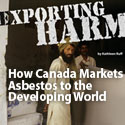Kathleen Ruff, RightOnCanada.ca
On May 29, 2014, the Zimbabwe government released its Position Paper on Chrysotile Asbestos. The Position Paper incorrectly states that the World Health Organization (WHO) embraces “controlled use” of chrysotile asbestos.
This statement is false. The position of the WHO is that chrysotile asbestos cannot be safely used and that all use of chrysotile asbestos should stop.
A letter was sent to Margaret Chan, Director-General of the WHO, requesting that the WHO officially ask Zimbabwe to correct this misrepresentation of the WHO position on asbestos.
On instruction from Director-General Margaret Chan, the WHO has now confirmed that it has asked the Zimbabwe government to correct the misinformation. The WHO says: “We are confident that action to correct the inaccurate statement regarding WHO’s position will be taken as soon as possible.”
As part of its tactics to sell asbestos, the asbestos industry has for the past many years falsely claimed that the WHO supports the industry’s position that chrysotile asbestos can be “safely used”.
The asbestos industry has now been officially notified by the WHO to correct this misinformation. No matter which way it responds to the WHO request, this represents a humiliating defeat for the asbestos industry and an exposure of its deceptive practices. If the industry removes the misinformation from the Position Paper, it will be admitting that it put forward false information. If it refuses to do so, it will show that it refuses to correct false information.
Zimbabwe intends to export 90% of the asbestos it mines, if the mines are re-opened.
Zimbabwe Position Paper on Chrysotile Asbestos
The Position Paper, now official Zimbabwe government policy, was written by the Zimbabwe National Chrysotile Taskforce. The Taskforce was composed of the company that owns the Zimbabwe asbestos mines (Turnall Holdings Limited), various government ministries (such as the Ministry of Mines, the Ministry of Commerce, the Ministry of Foreign Affairs and the Ministry of Health and Childcare), and unions, such as the Associated Mine Workers Union of Zimbabwe, and (shamefully) the Zimbabwe Medical Association.
At the official launch of the Chrysotile Asbestos Position Paper in Harare on May 29, 2014, Zimbabwe’s Industry and Commerce minister, Mike Bimha, urged the construction industry, corporate, government departments’ local authorities, individuals and other users of asbestos products not to be intimidated by anti-asbestos sentiments.
Speaking at the launch, Russia’s third secretary to Zimbabwe, Nikita Buturlin, said that Zimbabwe and Russia, as the major chrysotile asbestos producing countries, should share the same approaches and views regarding the “safe use” of this mineral. “It has been proven that our chrysotile deposits do not pose a threat to workers,” stated Buturlin.
David Bernstein, a consultant who has worked closely and lucratively with the asbestos industry for more than a decade after previously working for the tobacco industry for 18 years, also spoke at the event. The Zimbabwe Herald reported that Bernstein indicated that no evidence has as yet emerged that links chrysotile to lung related diseases.
The Position Paper refers to jobs that would be created if the asbestos mines were re-opened. The people of Zimbabwe need and deserve good jobs, not jobs in a deadly industry that destroys the lives of workers, nearby residents and populations of countries where the asbestos would be exported.
As well as misrepresenting the WHO, the Taskforce and the Zimbabwe government also misrepresented the position of the ILO, stating: “The ILO embraces the concept of controlled-use in Chrysotile asbestos.”
Like the WHO, the position of the ILO is that chrysotile asbestos cannot be safely used and that all use of chrysotile asbestos should stop.
A letter has been sent to the ILO requesting that it, like the WHO, ask the Zimbabwe government to correct the inaccurate representation of the ILO position on asbestos.



Sun, Jul 27, 2014
Asbestos